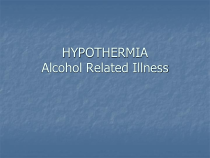 PPT
PPT
【文档说明】Hypothermia-PhiladelphiaUniversity:低温-课件.ppt,共(42)页,276.515 KB,由小橙橙上传
转载请保留链接:https://www.ichengzhen.cn/view-2958.html
以下为本文档部分文字说明:
HYPOTHERMIAAlcoholRelatedIllnessHypothermia-AlcoholHypothermiaEpidemiologyPhysiologyofTemperatureControlEti
ologyofHypothermiaPathophysiology/TreatmentHypothermiaandTraumaAlcoholEthanolIntoxicationPathophysiology/TreatmentAlco
holAbuseHypothermiaEpidemiologyDefinedastemp<35OC(<95OF)>700dieeachyearinUSfromhypothermia½ofthoseare65+yearsoldIndi
vidualsatageextremesandthosewithAMSareatgreatestriskPhysiologyofTemperatureControlConductionTransferofheatbydirectcont
actdowntemperaturegradient.ConvectionTransferofheatbymovementofheatedmaterial.(i.e.wind)RadiationLossofheat
fromnon-insulatedareasH2OEvaporationLossofheatthroughexhalationTemperatureHomeostasisOppositionofHeatLossHypothalamusSt
imulationofsympatheticnervoussystemiftempbelow„setpoint‟BehavioralresponsesWearingclotheswhenit‟scoldLeavingcoldenvironmentHeatGa
inShivering“Non-shiveringthermogenesis”EtiologyofHypothermiaAccidentalImmersionandnon-immersioncoldexposureMetabolicHypoendocrinestate
s(hypothyroid,hypoadrenalism,hypopituitarism)HypoglycemiaHeadtraumaTumorEtiologyofHypothermia(cont.)Wernicke‟sdisease.Dr
uginducedAlcohol(majorityofhypothermicpt‟sinUSareintoxicated)SedativesPhenothiazinesInsulinSepsisEtiologyofHypothermia(cont.)Severedermaldisea
seBurnsExfoliativedermatitisAcuteincapacitatingillnessSevereinfectionsDKAPsychoticdisordersOtherconditionscausingimpairedtherm
oregulatoryfunctionResuscitationwithroomtemperaturefluidPathophysiologyMildHypothermia34-36̊C(93.2-96.8̊F)ExcitationPhysiologica
djustmentstoretainheatModerateHypothermia32-34̊C(89.6-93.2̊F)AdynamicMetabolismslowsDecreasedO2demandDecreasedCO2productionSevereH
ypothermia<32̊9(89.6̊F)ShiveringceasesPathophysiology(cont.)ExcitationSympatheticresponse(HR,BP,andC
ardiacOutputallrise).AdynamicHR,CO,BPdecreaseduetonegativeino/chronotropiceffectsofhypothermiaPathophysio
logy(cont.)HypothermicEKGchangesOsborneorJwavesT-waveinversionProlongedPR,QRS,QTintervalsArrhythmiasmayincludebrad
ycardia,slowAF,VF,orasystoleExample26°C28°C28.5°C29.5°CabcdPathophysiology(cont.)Pathophysiology(cont.)Systemi
cEffectsofProgressingHypothermiaPulmonary:TachypneaRR&TVBronchorrhea,gag/coughreflexCNSDiscoordinationconfusionlethargycomaFurther
deteriorationmaybecerebro-protectiveRenal“ColdDiuresis”duetorenalhypoperfusion3rdspacinghemoconcentrationemboliccomplicationsrh
abdomyolysis,etc.CoagulopathyTreatmentStopfurtherheatlossBeginwarmingprocessPassiveexternalwarmingActiveext
ernalwarmingActiveinternalrewarmingWarmedoxygenandIVfluidsTreatment(cont.)MaintainhorizontalpositionVerticalpositionmaycompromisecerebralandsyst
emicperfusionAvoidroughmovementsandactivitiesHandlevictimgentlyduringCPR,intubation,BVMventilation,vasculara
ccessTreatment(cont.)CardiacArrestIfVFpresent:Defibrillatex3prnETTw/warmed,humidifiedO2WarmedIVfluids(avoidoverhydration)Iftemp<30̊
C(86̊F)CPR,limitshocksx3WithholdIVmedsContinuerewarmingTreatment(cont.)CardiacArrest(cont.)Ifte
mp>30̊CCPRDefibprnascoretemprisesIVmedsasindicated(longerthannormalintervals)ContinuerewarmingduringtransportOtherTreatmentCo
nsiderationsAMSNarcan2mgIVThiamine100mgIVD50/W25gmIVifBGLTreatment(cont.)PassiveRewarmingRemovalfromenvironmentI
nsulationActiveCoreRewarmingInhalationrewarmingHeatedIVfluidsGItractlavageBladderlavagePeritoneallavagePleurallavageExtracorporealrewar
mingMediastinallavageActiveExternalRewarmingWarmH2OImmersionHeatingblanketsHeatedobjectsRadiantHeatForcedairRewarmingCautionAfter-dropPh
enomenonTemperaturedropandacidosisprovokeseriousarrhythmiasColdacidoticbloodcausesdropincoretempColdbloodfromdilatedperipheralvesselsca
rrieshighlacticacidlevelstocorevesselsPeripheralvasodilation(BPdrops)InitialactiveexternalrewarmingleadstoHypothermia–TraumaPt.Threemechanismst
hatcontributetohypothermia-inducedcoagulopathyintraumainclude:1.PlateletDysfunction2.EnhancedFibrinolyticActivity3.Alt
erationInEnzymeFunctionsHypothermia–TraumaPt.PlateletDysfunctionInhibitionofThromboxaneB2productioncausesthenormalresponseo
fplateletaggregationtodecrease.Theplateletsarethereforestoredinthespleenandliver,andleftunavailableforuse.Hypothermia–TraumaPt.Enha
ncedFibrinolyticActivityTrauma-inducedhypothermiacausesaheparin-likesubstancetobereleased,thuscausingadisseminatedint
ravascularclotting(DIC)-likesyndrome.Thisismarkedbyanincreaseinprothrombin(PT)andpartialthromboplastintimes(PTT),andanincreaseinfibrinsplitpr
oducts.Hypothermia–TraumaPt.AlterationInEnzymeFunctionsHagemanfactorandThromboplastinareneededtoformclotsatthesiteofi
njuredendothelium.Hypothermiaaltersthefunctionoftheseenzymesandothers,thereforeincreasingbleedingandclottingtimes.Hypothermia–
TraumaPt.Coagulopathy–PerpetuatedBloodtransfusions/fluidresuscitationmayleadtoorexacerbatehypothermia.
Silbergleitetalreportthatroom(orambient)temperatureIVfluids,usedinresuscitation,increasehypothermiaormayactuallycausesecondaryhypothermiaintraumapa
tients.CrystalloidsdilutetheavailabilityofcoagulationfactorsBankedbloodislowinplateletsandclottingfactors,especiallyF
actorsVandVIIIHypothermia–NearDrowningCerebralProtectionProtectiveHypothermia(H2O<5̊C)corebodytemp<28̊CWatermustbei
cy.Heatlossmustoccurrapidlytometabolicratebeforesignificanthypoxemiabegins.VeryunlikelyforthistohappenMorecommo
nly,hypothermicneardrowninghavehighermortalityrate.AcuteEthanolIntoxicationEthanolMostfrequentlyusedandabused
intoxicant¾ofadultAmericanswillconsumeatleastonedrinkperyear36%willsmokeafagBeerisnumber4onthemostconsumed
beveragelist(pop,milk,coffee)AverageAmericanpounded2gallonsofpureethanol1997Downfrom2.77in1981EthanolDistilledspir
its40-50%(80-100proof)Someashighas75%Wine10-20%Beer2-6%OtherStuffMouthwash(upto75%)Cologne(40-60%)Medicinalpreparations(as
highas65%)Pathophysiology-EthanolCNSdepressantStimulanteffectmayoccur@concentrationAbsorbedmainlyinsmallbowelAlsooccursinmouth,esopha
gus,stomach,andlargebowelMajoritymetabolizedbyliverSmall%excretedbylungs,inurine,orsweatPathophysiology-EthanolAlcoholandWomenMore
pronetoalcoholrelatedhealthproblemsSmallervolumeofdistributionNofirstpassmetabolismcapabilityAlcoholdehydrogenaseAlc
oholandPregnancyLowbirthweightinfantsFetalalcoholsyndromeFacialdysmorphologyMental/growthretardationEthanolIntoxic
ationSignsandSymptomsDisinhibitedbehaviorCNSdepressionNystagmusSlurredspeechmotorcoordination/controlEthanolIntoxicationSignsandSymptoms(co
nt.)BPhypotensionDuetoPVRand/orvolumelossTachycardiaRespiratorydepressionUsuallyinunhabituated
usersMorbidity/MortalityUsuallyduetoimpairedjudgmentsequelaeTreatmentSupportiveABC‟sPreparetosupportrespirationsAlter
edMentalStatus25gmD50/WprnNarcan2mgThiamine100mgEffectsofAlcoholAbuseTraumaandAlcohol4thhighestcauseofdeath,aftercoronarydisease,cereb
ro-vascularaccidentsandcancer.Maincauseofdeathbeforetheageof40years.40-50%oftrafficdeaths25-35%ofnonfata
lcaraccidents64%offiresandburns48%ofcasesofhypothermiaandfreezing~20%ofsuicidesImplicatedin40%offallsand50%ofmurders(victimsorcriminals)
.EffectsofAlcoholAbuseCNSAcuteIntoxicationAlcoholwithdrawalSeizuresHallucinationsWernicke‟sencephalopathyKorsakoff‟spsychosi
sDementiaDepression/antisocial/suicidalEffectsofAlcoholAbuseGastrointestinalEsophagealvaricesErosivegastritisHepatitis/liv
erfailurePepticulcerdiseasePancreatitisOropharyngeal,esophageal,gastric,hepaticandpancreaticmalignanciesEffectsofAlcoholAbuseCardiov
ascularHypertensionCardiomyopathyStrokeDysrhythmicevents(intoxicationorwithdrawal)Endocrine/MetabolicTesticularatrophyAlco
holicketoacidosisFolicacidandthiaminedeficienciesEffectsofAlcoholAbuseChallengesofEvaluationandTreatmentObtainingreliablehistory
ObtainingcooperativecareandevaluationDifficulttoreasonwith„theintoxicated‟EvaluatingunderlyingdisorderOftenoverlookedduetointo
xicatedstateComorbidcomplicationsofunderlyingorgansystemdysfunctioninchronicalcoholicAffectspt.presentationandresponsetotrea
tmentEffectsofAlcoholAbuseHypothermiaMostcasesrelatedtoETOHuseContributestocoolingvia:DepressingcentralthermoregulationVasodilitationDepres
sedshiveringSedativeeffectsabilitytoremoveoneselffromacoldenvironment.PoliceinPolandsaythatabouthalfofthe270peoplewh
ohavefrozentodeathsofarthiswinterweredrunk.BritishBroadcastingCorporation©2001-2002EffectsofAlcoholAbuseWithdraw
alPeaksxusually~48hrsafterlastdrinkAutonomichyperactivityCardiacdysrhythmiasTremor/anxietyAgitationVisualdisturban
cesSeizuresEffectsofAlcoholAbuseWithdrawalTreatmentSupportive(ABC‟sprn)AMSThiamine,D50/W,NarcanIfseizing/tremorsV
ersed2.5-10mgMagnesium2gm
 辽公网安备 21102102000191号
辽公网安备 21102102000191号
 营业执照
营业执照